Helianthus tuberosus
There are a couple of common misconceptions you should quickly forget when first adding this sunny and brilliant plant to your yard.
A quick rundown: it’s not from Jerusalem, and it’s most definitely not an artichoke!
On the other hand, there are two things that you absolutely should remember: it’s not only a beautiful flower, but its roots (called “tubers”) make for a delicious food crop, too.
Together, food and gardening pleasures have made this botanical a floral delight and culinary favorite for many thousands of years – among Native American peoples and Europeans alike – with a deep history behind its rise to global recognition.
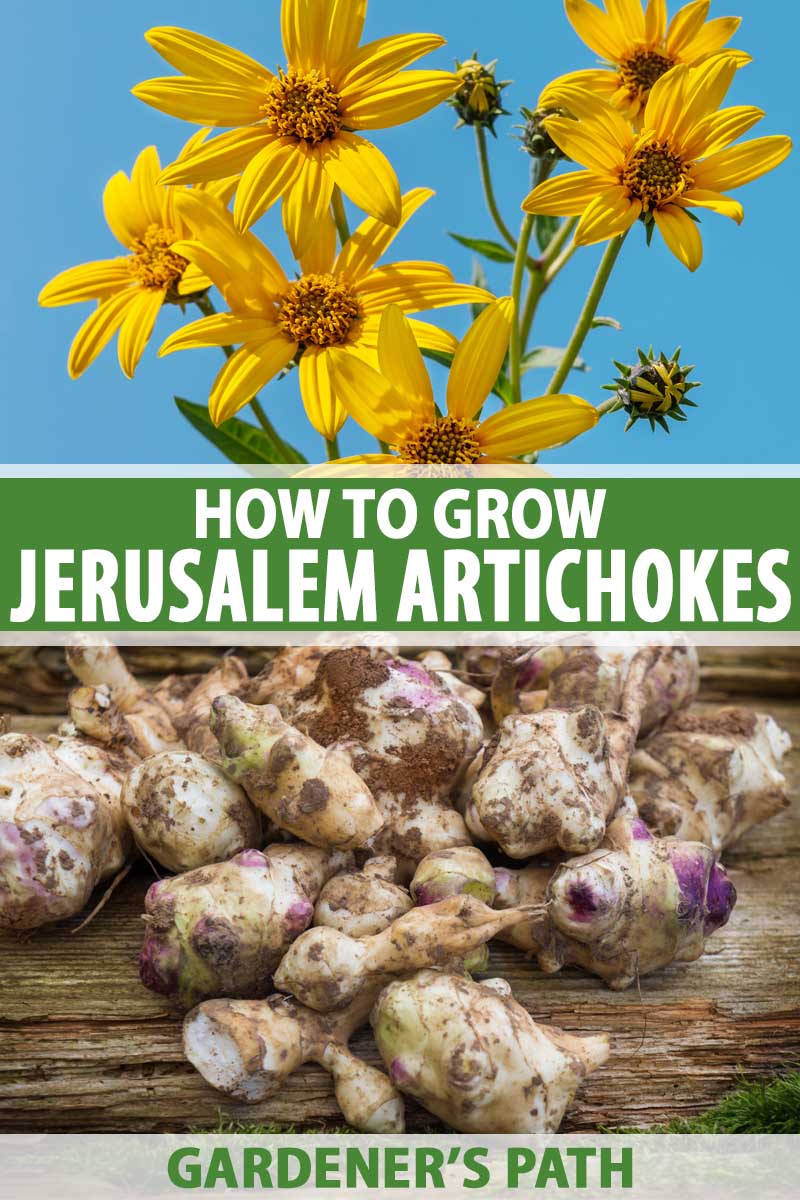
We link to vendors to help you find relevant products. If you buy from one of our links, we may earn a commission.
It’s true that some amazing traits of this yellow blossom made it tantalizing enough to carry across the Atlantic Ocean – and we’ll explore that together in this article.
Beyond horticultural use, the Jerusalem artichoke may see a resurgence in its popularity, with some new and interesting revelations on its potential health and healing use. There’s a lot to learn about the history of this fascinating plant, how to cultivate it in your garden, and the best ways to utilize it in your cooking and at-home healing once it’s ready to harvest.
Let’s take a look!
What You’ll Learn
Cultivation and History
Also called sunchokes, Jerusalem artichokes (Helianthus tuberosus) are distant relatives to the hearty, many-layered globe artichoke that you commonly see at the supermarket, or in Mediterranean cuisine.
It’s important to avoid getting them mixed up, though – they taste very different, and different parts of each plant are used in cooking and medicine.
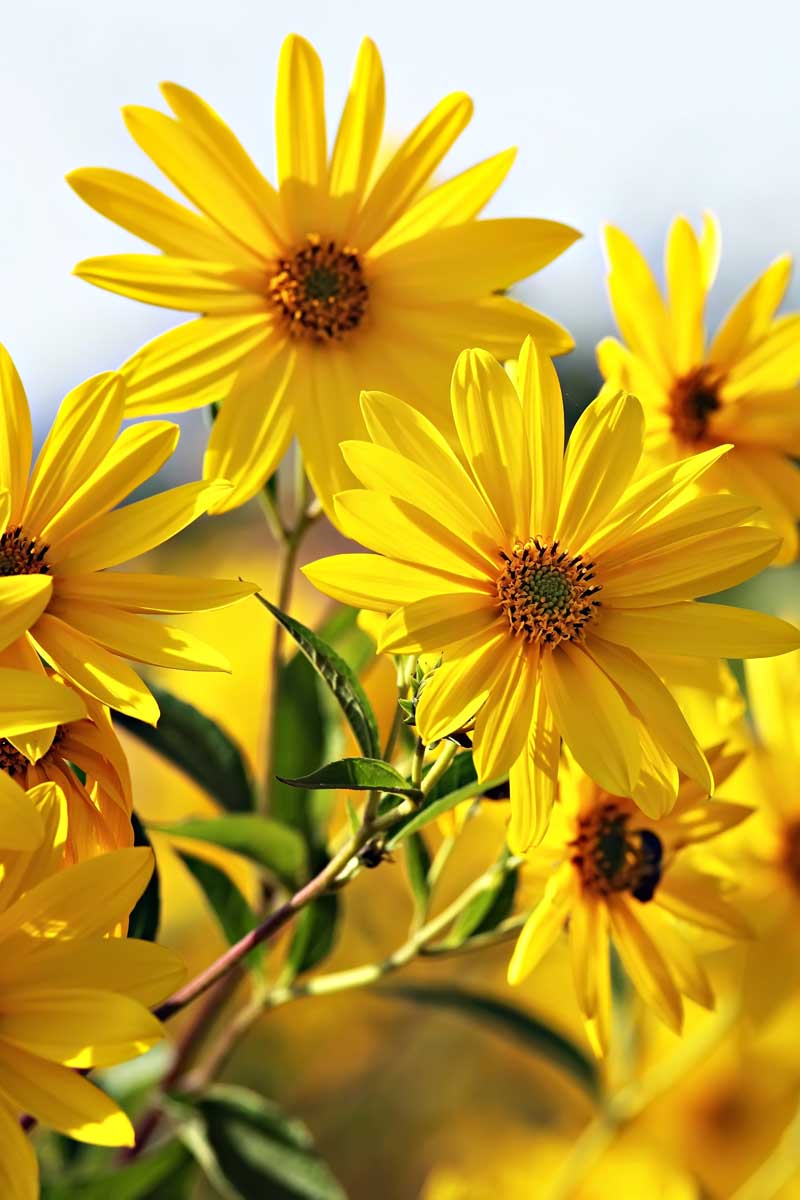
Unlike globe artichokes, these sunflower-reminiscent plants are actually native to North America, not the Mediterranean or Israel.
It was believed that native tribes of the Central Plains grew them as food and medicine, and spread them by way of trade to other tribes all over the rest of the continent, since they are very nutritious and simple to grow.
When French settlers arrived in America, they found sunchokes being cultivated as far east as Cape Cod, Massachusetts. Taking interest in the crop, they brought the tuber back over the Atlantic to Europe.
There, it became a mainstay of French cuisine, as it remains today. The tasty, tuberous culinary delight is often considered a nuttier, sweeter version of the potato for culinary purposes, with countless French recipes in circulation.
Over the hundreds of years since it was introduced to the Western world, various cultivars and varieties have been selected, bred, and perfected for taste and tuber size. Many glorious colors are available to select from as well, to enhance the beauty of any meal.
A combination of European and Native agriculture and cuisine brings us the knowledge and techniques you can easily use to grow and eat this heart-warming plant – or even add it to next season’s garden plan!
Propagation
The nice thing about growing Jerusalem artichokes: you don’t have to start them from seed. Obtain tubers in the spring from a local farming or gardening store, or seek them out online, to provide the starting “source” of your crop.
It’s better to start with small, younger tubers. Don’t feel the need to get larger ones, as more mature tubers tend to have a harder time with transplant in their older age (though most could still handle it, if necessary).
Spacing:
The “right” spacing depends on how many you wish to produce for your kitchen (or for decoration and enjoyment otherwise, of both the flowers and the tubers).
If you want a small patch to start out with, plant about 14 inches apart.
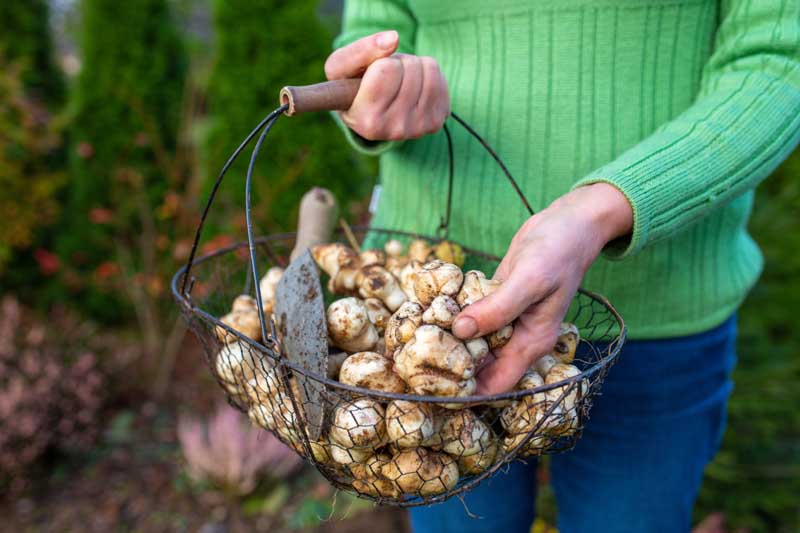
If you want tons of tubers and an expanding patch, you can plant each them about 5 feet apart, setting up the size of your space accordingly.
Add compost or natural fertilizer around your tubers to get them started. It’s not likely that they will need feedings once they mature.
Water around your tubers once after planting, until moist. Afterwards, unless conditions are exceptionally dry, you won’t be required to attend too much to their watering needs.
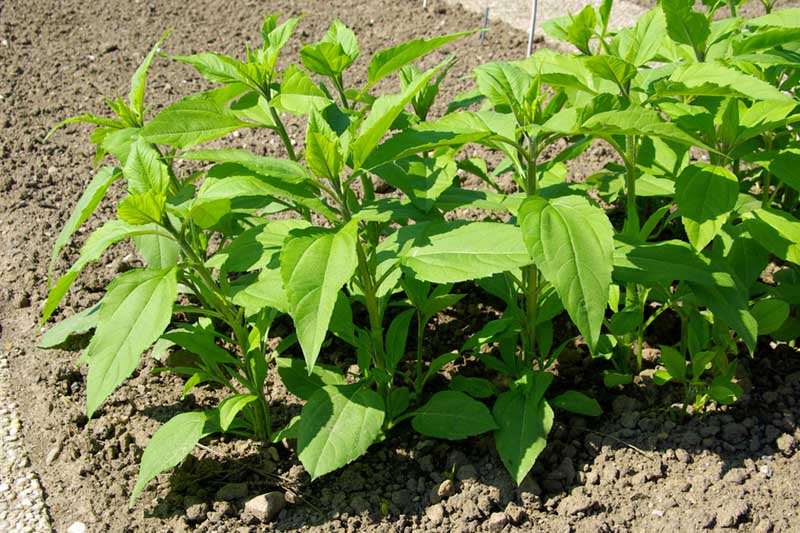
Select a slightly acidic to neutral, fully sunny, and well-drained site where you can dig up the soil and place your tubers, and be sure to remove all competing weeds from the site. Place your tubers in the ground, root-down and stalk-up, around 5 inches deep, and cover.
You can also elect a large tub or planting container for easy transport, or to prevent invasion of the rest of your garden – or, try digging a tub or container straight into the ground to “fence in” your tubers, so they won’t go wild.
Most importantly, keep them away from other plants! Not only will they spread and overtake nearby plant beds if they’re not harvested or thinned regularly, the spindly flowers will also grow to heights of 5 feet on average (10 feet max), casting shadows and depriving nearby plants of necessary sunlight.
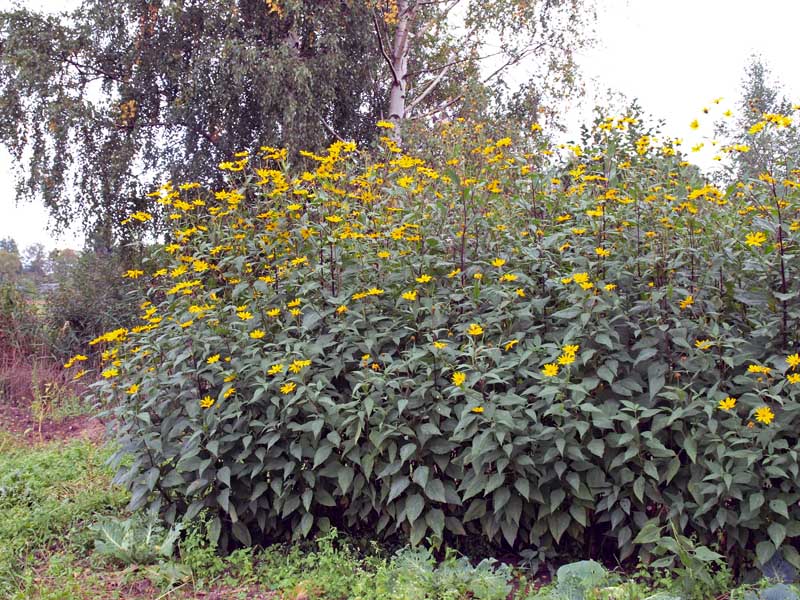
Early spring is a good time to start this plant, as it can tolerate frost. For the speediest and most optimal growth, however, plant it after all threat of frost has passed.
Sunchokes are so hardy you can try planting them at any time of year, so long as the ground is workable and not frozen – though it may be less ideal to plant a new tuber going into the winter, as such conditions are difficult for transplants.
How to Grow
Most seasoned gardeners report that getting these plants started is effortless and hassle free.
The bigger challenge, however, may be in maintaining your patch in a way that keeps these from spreading and crowding out your other plants.
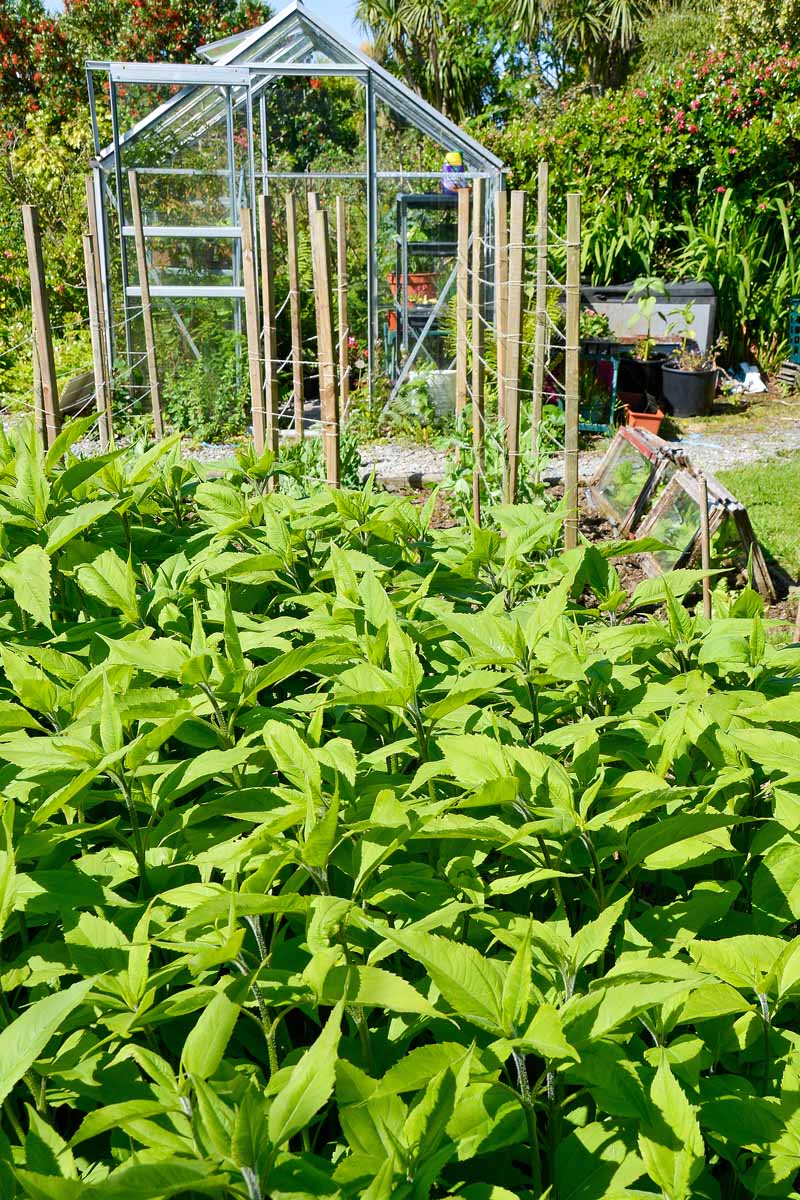
If left to their own devices, Jerusalem artichokes will spread aggressively and voraciously, so it’s good to keep an eye on how they are grown, by giving them a strategic yet supportive outdoor placement.
There’s not a whole lot to manage with Jerusalem artichokes. Since they can become quite tall plants, you will have to make sure the wind, weather, or other factors won’t cause them to topple.
After you’ve planted fresh tubers and the first stalks push up, consider placing even more soil at the base for stability.
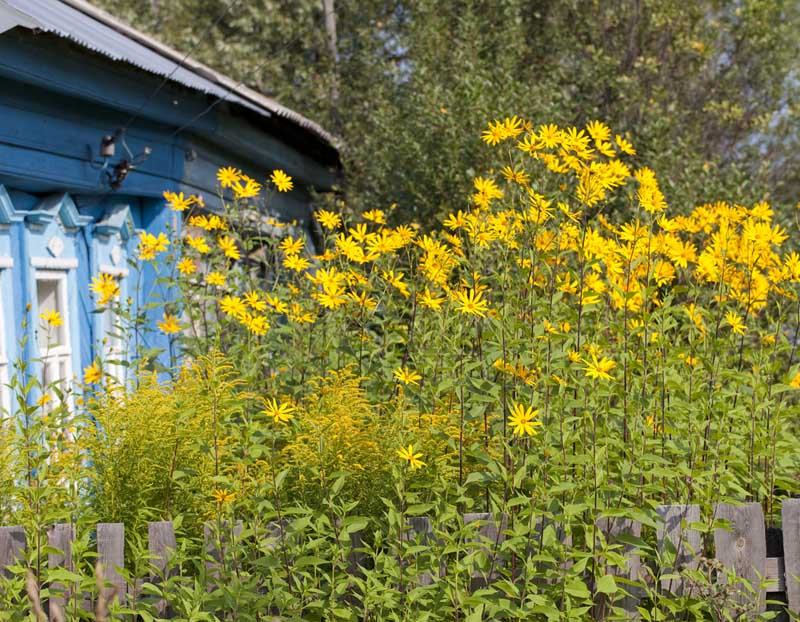
You can add another layer of compost or soil, about 6 inches or so right around the base, to keep top-heavy plants from falling over.
Initial baby tubers will need much more watering attention than grown plants. Even then, they don’t need much compared to other high-maintenance plant species and cultivars.
As soon as your patch seems self-sustaining, you can leave the watering up to nature. In droughts and dry conditions, give your plants a little extra watering attention.
Growing Tips
- You can stake, cage, or trellis your sunchokes, much like you would any sunflower (a close relative).
- The plant’s towering stature can form excellent staking or “living trellises” for other vining plants, like runner beans or peas.
- Cut flower heads off the plant during mid-summer to make them less top heavy. Use them as a summer bouquet or decoration for your home.
- Removing flowers before seeds form also helps to keep the plant from spreading, and becoming invasive to other parts of your garden. Heading into the fall, it redirects energy back to the roots, ensuring the growth of larger and meatier tubers.
Cultivars to Select
Wondering which kind of sunchoke is the best match for your garden and culinary needs?
Here’s the lowdown on some of the most prominent, flavorful, colorful, and easy-to-grow varieties:
Stampede
Thick, round, knobby, cream-colored tubers make for the most standard and “original” of all varieties. These are the most “potato-like” producing roots that can weigh over 1/2 pound each. These store well and can be eaten cooked or raw.

Stampede produces six to eight foot plants which flowers in July. This variety matures over a month before wild varieties and is winter hardy.
You can buy this variety from Yumheart Gardens via Amazon.
Red Fuseau
Long and thin or “top-shaped” reddish-purple tubers that take a little longer to mature, but are easier to clean and prepare than others, due their less “knobby” and “craggy” roots, which can hide hard-to-remove dirt.

Red Fuseau Jerusalem Artichokes
This variety has crunchy, sweet flavor and is cold hardy. Plants will grow as tall as 10 feet.
You can buy this variety from Yumheart Gardens via Amazon.
White Fuseau
These are similar to the red variety in that the edible parts are long and thin with no nodules on the tubers. This means that they usually come out the ground very clean. These tubers also have a lighter and thinner skin than most and have a superior flavor.

White Fuseau Jerusalem Artichokes
This variety ripens later than many others, but is suitable for most soils.
You can buy this variety from Yumheart Gardens via Amazon.
Waldspinel
‘Waldspinel’ Means “Gem of the Forest” in Austria where this cultivar originated from. A very long, red variety that is often called the “fingerling” of sunchokes, it has a earthy, nutty flavor.
Managing Pests and Disease
Once you have your first round matured and grown, it takes little encouragement to keep them alive and thriving – with mild watering and harvesting only being occasional tasks.
Jerusalem artichokes tend to thrive. Diseases and pests are not a major concern, as they have maintained strong enough wild genetics to easily resist them.
Slugs, snails, sclerotinia rot, and aster yellows are the four issues to look for:
Snails and Slugs
Snails and slugs are usually only a risk to young, developing tubers. Beer traps and copper can keep them successfully at bay. You can find out more in our Snails and Slugs Guide.
Sclerotinia Stem Rot or White Mold
This a disease caused by the fungus Sclerotinia sclerotiorum which causes plants to develop a mushy, rotting stem base and white mold on the outside. Remove affected plants right away – you will have to eradicate the whole patch, since the disease stays in the soil for long periods.
Aster Yellows
Like other members of the Asteraceae family, Jerusalem artichokes are affect by the disease known as “aster yellows.” This disease is caused by microscopic, bacteria-like organisms known as phytoplasmas and caused significant disfigurement in the leaves, flowers, and roots of the infected plant.
The only cure is to remove infected plants and destroy infected plant material. If the disease persists, do not plant any Asteraceae family plants in the area for several years and keep related weeds, such as dandelion and plantain, from growing in the plot.
Read more about aster yellows here.
Harvesting
The biggest reward of growing these sunny plants may just be dining on them – though first you must harvest your cash crop before preparing it for cooking use.
When the first beginnings of cold weather arrive in late fall or early winter, it’s time to grab your spade or shovel and revisit your patch for harvesting. Pulling up these tubers can be not all that different from harvesting potatoes.
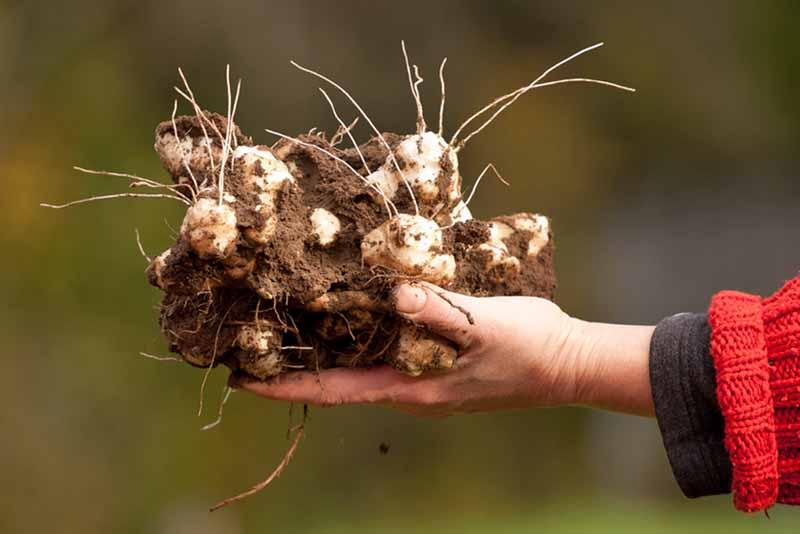
Waiting until the arrival of the coldest temperatures in your area may seem a bit strange compared to how you would harvest most other veggies (usually done BEFORE the threat of frost). But Jerusalem artichokes are tough, and you will find in time that cold weather has a surprisingly tasty effect on your culinary experience!
Work a shallow shovel or spade about 1 foot (sometimes 2 feet in more established patches, since new tubers may develop deeper) into the soil around each individual patch, or a stand within your larger patch.
Loosen and remove tubers you want to save for eating from the ground, and leave the rest in the soil for re-growth (and more tubers next year). Be thorough and feel around in the soil for tubers with your fingers, using gloves if necessary.
You may remove larger “choice” tubers and leave smaller tubers behind without worrying about any problems with re-propagating.
If you have an especially crowded, dense patch (or suspect a lot of expansion happened over the season), opt for a digging fork instead of a shovel. This will help you to avoid inadvertently chopping or otherwise damaging Jerusalem artichokes that you want to keep intact for future growth and harvests.
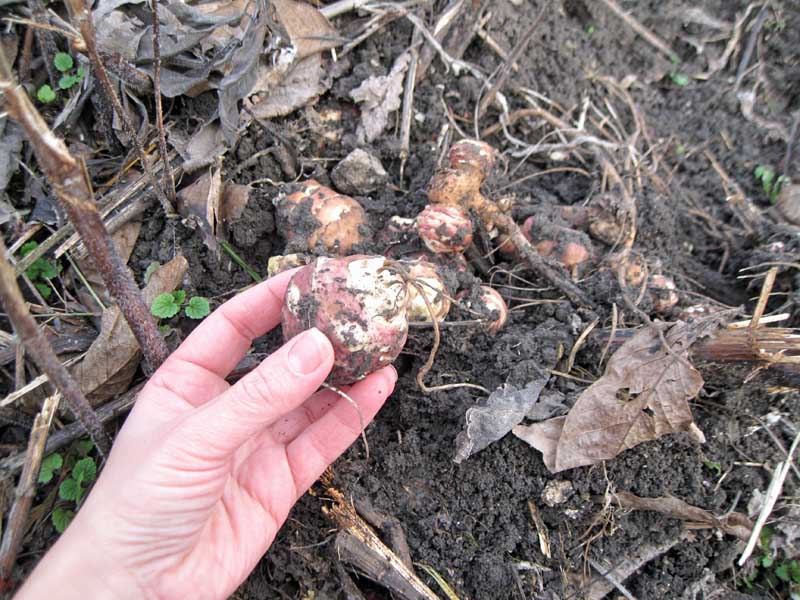
Rinse and clean away all dirt from tubers with water before storage, and make sure they are completely dry before stowing them away. If you’re concerned about leftover water after cleaning, gently dry your tubers with a clean cloth or napkin before storing.
Harvesting after soil temperatures have cooled improves the texture and flavor of the tubers – making fall or winter prime gathering times. Frosts are known to “sweeten up” the plant, as is also the case for wintered or post-frost harvested kale, parsnips, or spinach.
Keeping frosts in mind as having a potentially beneficial effect on your harvests is the best reason for waiting to do any sunchoke gathering until the cold weather arrives. Cold soil and frost greatly improve sunchoke flavor!
Colder climates with frigid winters yield excellent fall harvests, while those with less intense winters can wait until wintertime itself – or even harvest tubers constantly throughout winter as needed, given that the ground is not frozen – and yes, your sunchokes can handle winter harvests well, due to their ingrained natural winter hardiness (a trait that hasn’t been bread out of them through domestication).
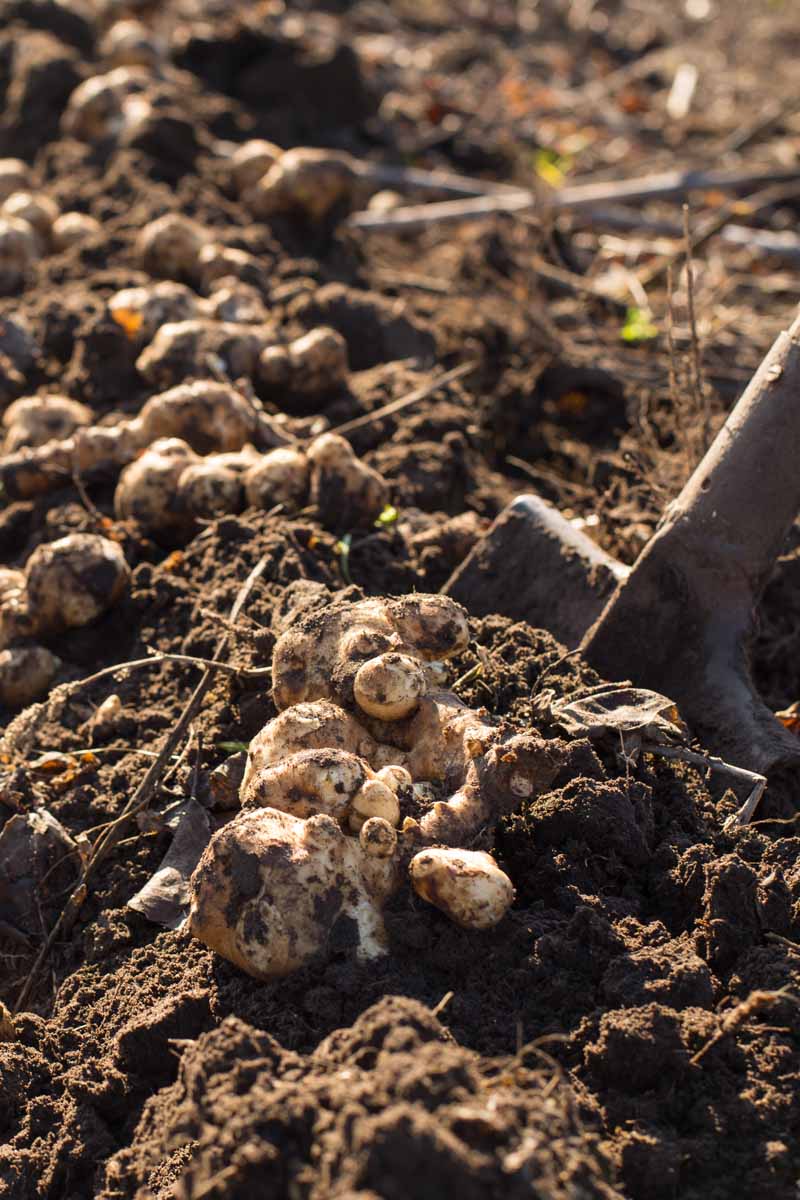
If you want to keep tubers for re-planting, selling, or giving away to plant-savvy friends, hold on to your smaller roots for easier transport and rejuvenation.
Whether for food or future seed propagation, it’s best to store your tubers in a cool, dry place like a fridge or root cellar, in paper bags for optimal dryness.
Planning Ahead
Don’t want the plants to return next year? If you’re not intent on having more harvests in seasons to come, make sure you are thorough in removing ALL tubers from your plot, even the smallest – or else you can expect robust plants to re-emerge in the spring!
Keep in mind – sunchokes spread prolifically. This is good for storing many yummy tubers, though it’s bad for weed and pest control.
Check all areas of your plot or bed thoroughly, just to be sure that you’ve culled them all, even if you don’t expect that they have spread.
Recipes and Cooking Ideas
Now, on to the most exciting part of growing these plants – add them to delicious meals!

Sunchokes have been incorporated widely into certain cuisines, including French and other European styles, though their general popularity has diminished in the years since World War II – a period when the plant provided cheap, easy-to-grow food during economically difficult times.
After the war ended, these starchy tubers gained the reputation of a “poor man’s food” and fell into obscurity, entirely absent from fine dining menus. Regardless, sunchokes still hold a precious status in various traditional European dishes.
The tubers may be eaten raw or cooked, and they closely fit the same niche and flavor profile as some varieties of potato.
Prep, Cooking, and Eating
- Scrub-a-dub- Tubers should be given a good scrub under cold running water before cooking, to remove any leftover dirt.
- Peel away (or not)- Some may opt to peel their thin skin, but this is optional. Using a vegetable peeler can be helpful. If you’re in the market for a new one, we like the OXO Good Grips Swivel Peeler, a best seller on Amazon.
- Add a “twist”- Sprinkling lemon juice (homegrown, maybe?) directly onto the cut vegetables (or adding some to a bowl of cold water that you place your cut or shaved sunchokes into before further prep) can help to prevent oxidation, the same browning or darkening process that happens when a cut apple or potato is exposed to air. Adding a little extra just right before serving tastes great too, really bringing out the sunchoke’s flavors!
- Be careful- The tubers contain a carbohydrate called inulin that may cause intestinal gas, discomfort, and even diarrhea (especially if eaten raw) – much like beans or other legumes.
- So many cooked options- Like potatoes, you can bake, saute, fry, or roast these. Try making a puree, whip, or mash, or even cream them into a sauce or soup.
- Salads- Some lovers of these crisp, nutty tubers enjoy them raw, cut into matchsticks or sliced paper thin, and served on salads or atop other dishes.
To get those paper-thin veggie slices, you’re going to need a mandoline. Try the Benriner Japanese Mandoline Slicer, a best seller on Amazon.
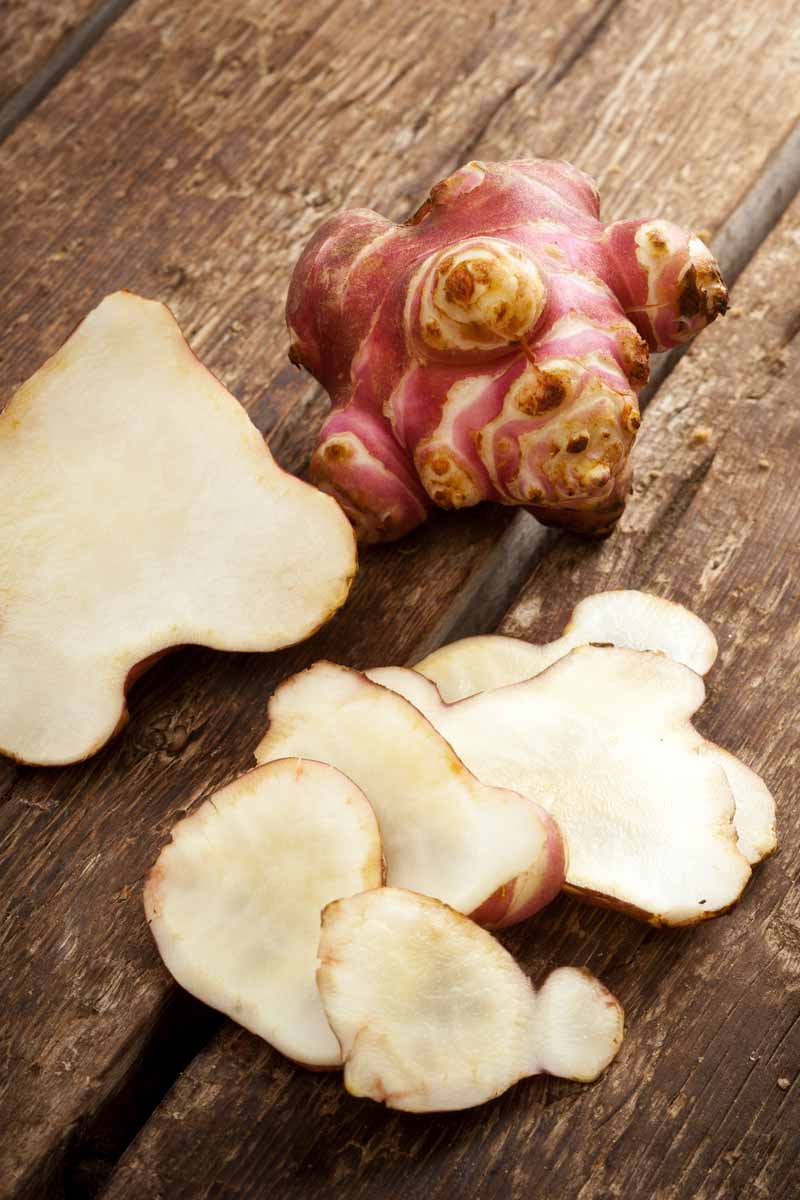
Consider adding the tuber to dishes that enhance and complement its flavor profile, such as those made with the following ingredients:
- White Wine
- Olive Oil
- Sunflower Oil
- Butter
- Cream
- Parsley
- Ginger
- Black Pepper
- Cumin
- Nutmeg
- Garlic
- Potatoes
- Chicken Stock
- Bacon
For more suggestions on how to pair the vegetables, fruits, and herbs that you harvest with other ingredients, check out Karen Page and Andrew Dornenburg’s expert book on the subject, “The Flavor Bible.”
Health and Healing
NutritionData.com reveals that this nutty, smoky-flavored tuber is known to contain significant amounts of vitamins B1 (thiamine), B3 (niacin) and C.
It’s also a significant source of minerals including copper, iron, phosphorus, and potassium, while providing macronutrients like complex carbohydrates, healthy fiber, and protein.
A Note of Caution
The health information in this article is not intended to assess, diagnose, prescribe, or promise cure. Consult with your health care professional before considering any of these easy-to-grow herbs for your health and wellness.
As seen in a recent medical research review, Jerusalem artichokes have drawn the attention of modern medicine: the tuber produces significant amounts of inulin, a natural polysaccharide (read: a storage carbohydrate and dietary fiber) that has shown beneficial effects on Type 2 diabetes and leaky gut syndrome management.
Keep in mind, the longer you store the tubers, the less inulin they will contain. The quantity will diminish and eventually fade away over time, rendering them closer in nutritive value to potatoes.
Quick Reference Growing Guide
| Plant Type: | Flower tuberous perennial | Flower/Foliage Color: | Yellow/green, bronze |
| Native to: | North America | Maintenance: | Low |
| Hardiness (USDA Zone): | 3-9 | Tolerance: | Some drought and cold weather |
| Season: | Flowers in the summer; harvest in the autumn | Soil Type: | Prefers slightly acidic soils but will adapt to a wide range of soil types and pH. |
| Exposure: | Full sun to part shade | Soil pH: | 5.8-7.0 |
| Spacing: | 12-24 inches, depending on variety | Soil Drainage: | Well-draining |
| Planting Depth: | 4-6 inches (tubers) | Attracts: | Beneficial pollinators |
| Time to Maturity: | 3-5 months, depending on variety | Family: | Asteraceae |
| Height: | 8-10 feet, depending on variety | Genus: | Helianthus |
| Water Needs: | Moderate when planted, low after established | Species: | tuberosus |
| Common Pests: | Slugs and snails | Common Disease: | Sclerotinia stem rot, white mold, aster yellows |
For Growing, Dining, and Healing
With the mysteries of Jerusalem artichokes unveiled, it’s quite clear why they will make a smart addition to your garden – and why you should give them a try!
First, they’re quite easy to grow and manage. Even better, you will have a delicious food crop and beautiful blooms, all in one.
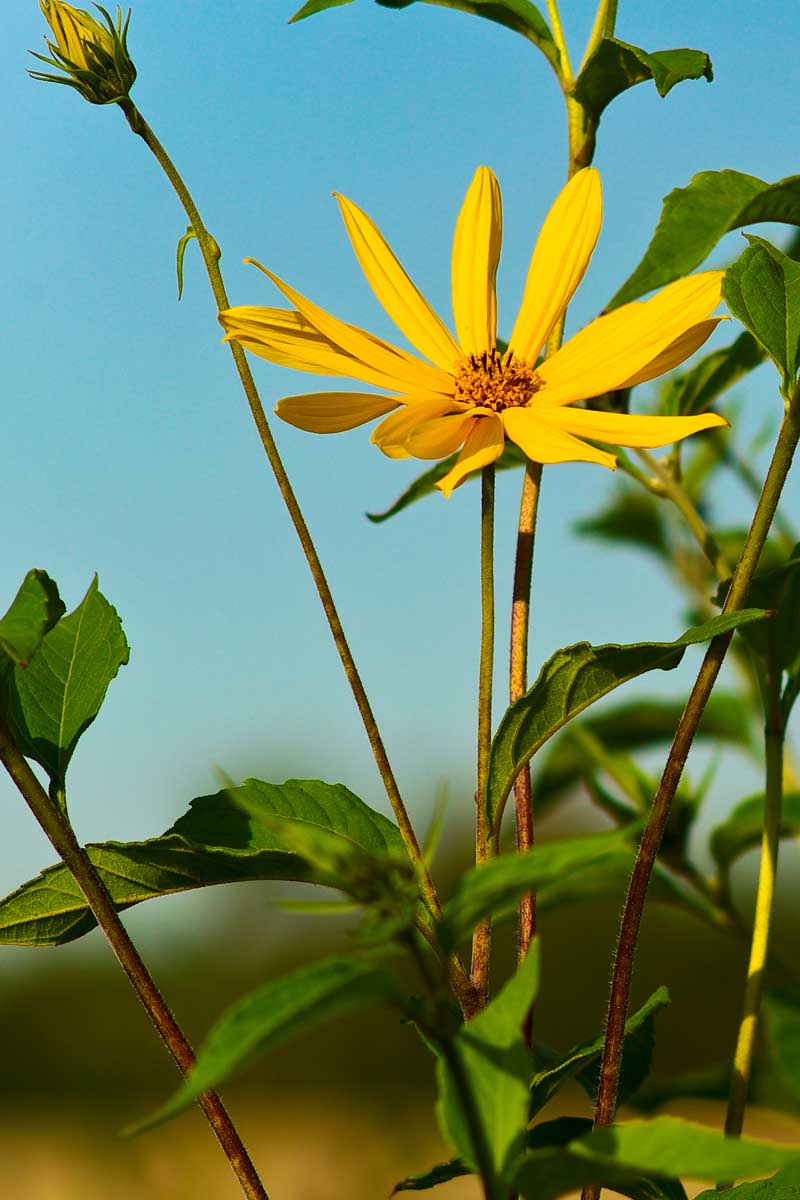
Not into the sweet and nutty potato taste? At the very least, you have a gorgeous flower to enhance the beauty of your yard – though you could be missing out on its potential health effects!
Either way, many different people and cultures have enjoyed growing sunchokes for thousands of years… with good reason!
If you’re an adventurous vegetable gardener, may you enjoy cultivating this tuber along with your other standard produce.
Have you had success growing Jerusalem artichokes in your own garden? Let me know in the comments!
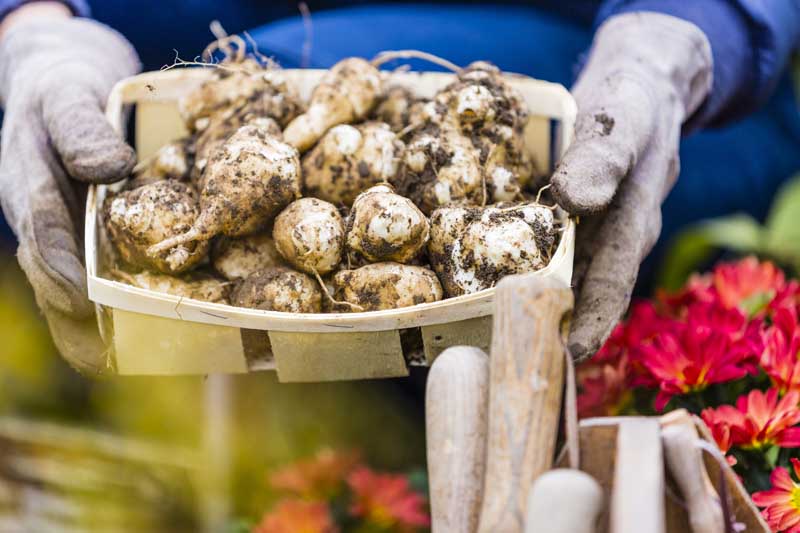
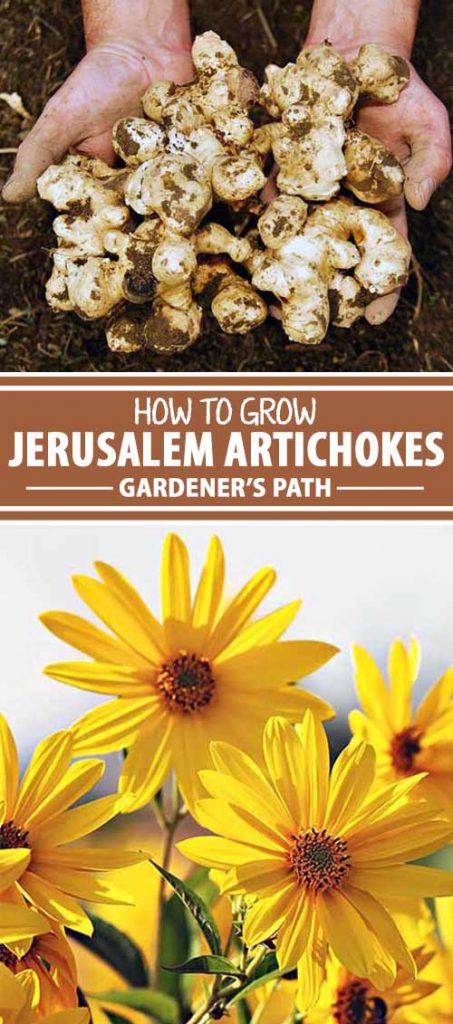
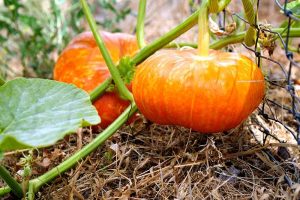
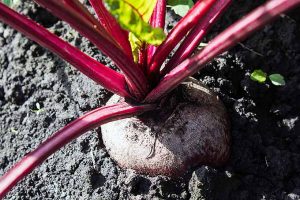
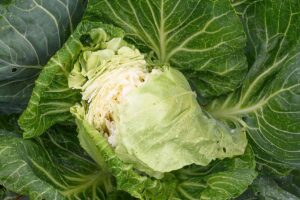
My artichokes are 10 ft tall but they do not bloom. It is mid-august. What am I doing wrong? I fertilize them and water them pretty heavily. But I also leave plenty of time in between waterings. Comments advice welcome
The first red flag that stands out in your message, John, is that you say you are fertilizing them heavily- too much nitrogen will lead to happy foliage growth, but little flowering. Lay off the fertilizer!
My J. Artichokes didn’t flower until October. They must bloom in the very late summer to fall timeframe.
I have grown them for years. We are in zone 7-B. I plant the smallest tubers into a richly amended soil in Feb or early March, and that’s it. I rarely even water. Ours grow to about 10′ tall and flower in late September. Also, they are in full sun.
Last year, I harvested about 20 lbs that resulted from tossing a few shriveled store bought chokes the previous year. I was careful to harvest them all, but this year,the patch has doubled in size. I kept the chokes in a large plastic bag lined in paper towels. They lasted for months.
I have had jerusalem artichokes in my yard in a flower bed for several years, and they gro very tall and multiply, with lots of small tubers, but never flower. Do they need special conditions? I do not add any special treatment, and the water is only the overspray from the lawn. Eventually the plants turn brown & die, but no flowers.
Have they ever flowered in this location, Valorie? If you’re getting healthy leafy growth, you may have an overabundance of nitrogen in your soil that is preventing flowering. And if they’re turning brown and dying early in the season, they could benefit from additional watering. But be careful not to water too much – these plants don’t like too much moisture, and they’re fans of full sun. You could have your soil tested, move them to a new location, or try supplementing with a balanced fertilizer that’s good for promoting blooms.
Thanks, great info !!
Hi, are the flowers of the plant edible? I am considering decorating focaccia bread with them.
Hi An-Magritt, I wouldn’t recommend trying to eat the flowers, the petals have small spikes on them, and are very fibrous – apparently they taste like resin!
My artichoke tubers came late (due to lockdown) and are only 2-3ft high now and haven’t flowered. Do you think I can still expect a crop of edible tubers or so do I need to wait for them to flower? Thanks
Where are you gardening, Sheri? A long growing season is important if you’re aiming for big roots, but these are perennials that will continue to produce year after year if conditions are right. The plants actually put more energy into producing roots when they haven’t flowered (rather than putting their energy towards producing seeds) and many gardeners actually cut the flowers when they form. With any luck, you may still get a good crop this year – and fortunately they benefit from a bit of cold as well.
How do the flowers handle being cut? I was thinking of growing some because they would look pretty in a vase.
These make lovely additions to bouquets and arrangements!
I grew them for the first time. I was given tubers last fall which I planted immediately. They survived the winter in a raised box and produced very nicely. I pulled most tubers out of the ground and left a few to produce next year’s crop. I now have to figure out how to use them in vegan recipes. I just roasted some and they were delish but I have a whole lot more to eat and hope my storage keeps them good until I can figure out how to incorporate them into recipes.
Enjoy the sunchokes, Lily! These are also delicious pan fried, steamed or boiled (in less water than you might typically use for potatoes- they can become mushy) and mashed, or sliced and baked in a vegan gratin made with dairy-free products. You can even thinly slice and use them raw in salads, dehydrate them to make chips, or grind the dehydrated chips into flour. Hope you have fun with your crop! A cool, dry, well-ventilated, dark location is best for long-term storage, and be sure to wait to wash them until you’re ready to eat or use them in recipes,… Read more »
There is an error in the description. It says the plant prefers slightly alkaline soil and then underneath under PH it says 5.8 to 6.2 which is definitely acid. So which is it supposed to be?
Thanks Christa! Good catch – they like slightly acidic to neutral pH but are very adaptable, and will thrive in most soils!
Hi
I am planting these for first time. I am in zone 8. Our area is snake heavy and I would prefer to keep the bush cut down… will this impact the tuber?
I’m afraid that will definitely impact the tubers. Photosynthesis aboveground is necessary for healthy tuber production belowground.